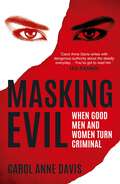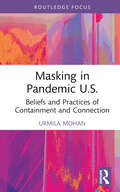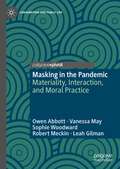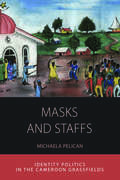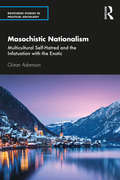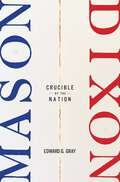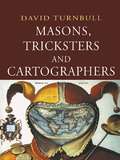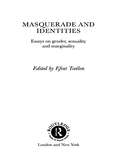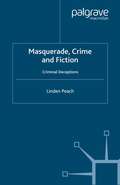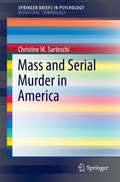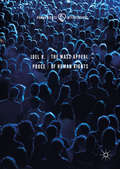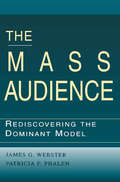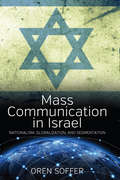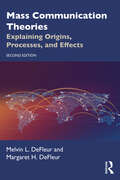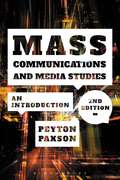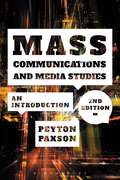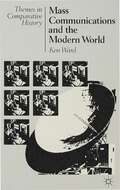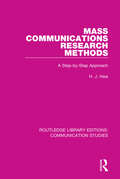- Table View
- List View
Masking Evil: When Good Men and Women Turn Criminal
by Carol Anne DavisIn this collection of incisive profiles, veteran crime writer Carol Anne Davis turns the spotlight on men and women from good backgrounds who crossed the line into depravity. Whether a model pupil, a trusted member of the clergy or the chief of police, these otherwise ordinary people revealed their hidden capacity for the darkest crimes.
Masking in Pandemic U.S.: Beliefs and Practices of Containment and Connection (Routledge Focus on Anthropology)
by Urmila MohanThis anthropological study explores the beliefs and practices that emerged around masking in the U.S. during the COVID-19 pandemic. Americans responded to this illness as unique subjects navigating the flux of social and corporeal boundaries, supporting certain beliefs and acting to shape them as compelling realities. Debates over health and safety mandates indicated that responses were fractured with varied subjectivities in play—people lived in different worlds and bodies were central in conflicts over breathing, masking and social distancing. Contrasting approaches to practices marked the limits and possibilities of imaginaries, signaling differences and similarities between groups, and how actions could be passageways between people and possibilities. During a time of uncertainty and loss, the "efficacious intimacy" of bodies and materials embedded beliefs, values, and emotions of care in mask sewing and usage. By exploring these practices, the author reflects on how American subjects became relational selves and sustained response-able communities, helping people protect each other from mutating viruses as well as moving forward in a shifting terrain of intimacy and distance, connection, and containment.
Masking in Pandemic U.S.: Beliefs and Practices of Containment and Connection (Routledge Focus on Anthropology)
by Urmila MohanThis anthropological study explores the beliefs and practices that emerged around masking in the U.S. during the COVID-19 pandemic. Americans responded to this illness as unique subjects navigating the flux of social and corporeal boundaries, supporting certain beliefs and acting to shape them as compelling realities. Debates over health and safety mandates indicated that responses were fractured with varied subjectivities in play—people lived in different worlds and bodies were central in conflicts over breathing, masking and social distancing. Contrasting approaches to practices marked the limits and possibilities of imaginaries, signaling differences and similarities between groups, and how actions could be passageways between people and possibilities. During a time of uncertainty and loss, the "efficacious intimacy" of bodies and materials embedded beliefs, values, and emotions of care in mask sewing and usage. By exploring these practices, the author reflects on how American subjects became relational selves and sustained response-able communities, helping people protect each other from mutating viruses as well as moving forward in a shifting terrain of intimacy and distance, connection, and containment.
Masking in the Pandemic: Materiality, Interaction, and Moral Practice (Consumption and Public Life)
by Owen Abbott Vanessa May Sophie Woodward Robert Meckin Leah GilmanThis book assumes an “everyday life” perspective towards masking in public spaces in the UK during the Covid-19 pandemic. Facemasks are perhaps one of the most tangible ways in which the changes wrought by the Covid-19 pandemic were made visible. In the space of a few months in 2020, masking in the UK went from being almost non-existent in public to becoming widespread, both before and after the UK government mandated masking in most enclosed public spaces in July 2020. In this context, the speed and scale of the introduction of masking in public settings offers sociologists a rare chance to document the (contested) emergence of a new social practice. The authors argue that the nature of masking during the pandemic means that masking practices need to be understood through the entwinement of material, interactional, and moral dimensions. By developing a relational perspective to explore the relationship between the materiality and moral significance of masking, and how this translated into the development of masking practices in public spaces, the authors argue further that the specific context of masking during the pandemic provides sociologists with a unique lens to think through the nature of material, interactional, and moral practices in general.
Masks and Staffs: Identity Politics in the Cameroon Grassfields (Integration and Conflict Studies #11)
by Michaela PelicanThe Cameroon Grassfields, home to three ethnic groups – Grassfields societies, Mbororo, and Hausa – provide a valuable case study for the anthropological examination of identity politics and interethnic relations. In the midst of the political liberalization of Cameroon in the late 1990s and 2000s, local responses to political and legal changes took the form of a series of performative and discursive expressions of ethnicity. Confrontational encounters stimulated by economic and political rivalry, as well as socially integrative processes, transformed collective self-understanding in Cameroon in conjunction with recent global discourses on human, minority, and indigenous rights. The book provides a vital contribution to the study of ethnicity, conflict, and social change in the anthropology of Africa.
Masochistic Nationalism: Multicultural Self-Hatred and the Infatuation with the Exotic (Routledge Studies in Political Sociology)
by Göran AdamsonThis book examines the nature of the conflict between right-wing populism and multiculturalism: the West’s defining conflict in the modern age. Drawing on a plethora of evidence from politics and culture in the West, it argues that these two positions, while antagonistic on the surface, are in fact similar: nationalism and multiculturalism are two names for one idea, the difference between them being simply a matter of geography; both outlooks have their roots in romanticism, sentimentalism, arrogance and a racist outlook. Rather than defend either approach, this volume urges us to consider the importance of roots and argues for greater consideration of what classical liberalism, socialism and feminism can do to break this impasse in our political thinking, with a concern for equality and concern for solidarity, regardless of cultural practice. As such it will appeal to social and political theorists with interests in political sociology and culture.
Masochistic Nationalism: Multicultural Self-Hatred and the Infatuation with the Exotic (Routledge Studies in Political Sociology)
by Göran AdamsonThis book examines the nature of the conflict between right-wing populism and multiculturalism: the West’s defining conflict in the modern age. Drawing on a plethora of evidence from politics and culture in the West, it argues that these two positions, while antagonistic on the surface, are in fact similar: nationalism and multiculturalism are two names for one idea, the difference between them being simply a matter of geography; both outlooks have their roots in romanticism, sentimentalism, arrogance and a racist outlook. Rather than defend either approach, this volume urges us to consider the importance of roots and argues for greater consideration of what classical liberalism, socialism and feminism can do to break this impasse in our political thinking, with a concern for equality and concern for solidarity, regardless of cultural practice. As such it will appeal to social and political theorists with interests in political sociology and culture.
Mason-Dixon: Crucible of the Nation
by Edward G. GrayThe first comprehensive history of the Mason-Dixon Line—a dramatic story of imperial rivalry and settler-colonial violence, the bonds of slavery and the fight for freedom.The United States is the product of border dynamics—not just at international frontiers but at the boundary that runs through its first heartland. The story of the Mason-Dixon Line is the story of America’s colonial beginnings, nation building, and conflict over slavery.Acclaimed historian Edward Gray offers the first comprehensive narrative of the America’s defining border. Formalized in 1767, the Mason-Dixon Line resolved a generations-old dispute that began with the establishment of Pennsylvania in 1681. Rivalry with the Calverts of Maryland—complicated by struggles with Dutch settlers in Delaware, breakneck agricultural development, and the resistance of Lenape and Susquehannock natives—had led to contentious jurisdictional ambiguity, full-scale battles among the colonists, and ethnic slaughter. In 1780, Pennsylvania’s Act for the Gradual Abolition of Slavery inaugurated the next phase in the Line’s history. Proslavery and antislavery sentiments had long coexisted in the Maryland–Pennsylvania borderlands, but now African Americans—enslaved and free—faced a boundary between distinct legal regimes. With the passage of the Fugitive Slave Act in 1850, the Mason-Dixon Line became a federal instrument to arrest the northward flow of freedom-seeking Blacks. Only with the end of the Civil War did the Line’s significance fade, though it continued to haunt African Americans as Jim Crow took hold.Mason-Dixon tells the gripping story of colonial grandees, Native American diplomats, Quaker abolitionists, fugitives from slavery, capitalist railroad and canal builders, US presidents, Supreme Court justices, and Underground Railroad conductors—all contending with the relentless violence and political discord of a borderland that was a transformative force in American history.
Masons, Tricksters and Cartographers: Comparative Studies in the Sociology of Scientific and Indigenous Knowledge
by David TurnbullIn an eclectic and highly original study, Turnbull brings together traditions as diverse as cathedral building, Micronesian navigation, cartography and turbulence research. He argues that all our differing ways of producing knowledge - including science - are messy, spatial and local. Every culture has its own ways of assembling local knowledge, thereby creating space thrugh the linking of people, practices and places. The spaces we inhabit and assemblages we work with are not as homogenous and coherent as our modernist perspectives have led us to believe - rather they are complex and heterogeneous motleys.
Masons, Tricksters and Cartographers: Comparative Studies in the Sociology of Scientific and Indigenous Knowledge (Studies In The History Of Science, Technology And Medicine Ser.)
by David TurnbullIn an eclectic and highly original study, Turnbull brings together traditions as diverse as cathedral building, Micronesian navigation, cartography and turbulence research. He argues that all our differing ways of producing knowledge - including science - are messy, spatial and local. Every culture has its own ways of assembling local knowledge, thereby creating space thrugh the linking of people, practices and places. The spaces we inhabit and assemblages we work with are not as homogenous and coherent as our modernist perspectives have led us to believe - rather they are complex and heterogeneous motleys.
Masquerade and Identities: Essays on Gender, Sexuality and Marginality
by Efrat TseëlonMasquerade, both literal and metaphorical, is now a central concept on many disciplines. This timely volume explores and revisits the role of disguise in constructing, expressing and representing marginalised identities, and in undermining easy distinctions between 'true' identity and artifice.The book is interdisciplinary in approach, spanning a diverse range of cultures and narrative voices. It provides provocative and nuanced ways of thinking about masquerade as a tool for construction, and a tool for critique. The essays interrogate such themes as:*mask and carnival*fetish fashion*stigma of illegitimacy*femininity as masquerade*lesbian masks*cross-dressing in Jewish folk theatre*the mask in seventeenth and eighteenth century London and nineteenth century France*the voice as mask.
Masquerade and Identities: Essays on Gender, Sexuality and Marginality
by Efrat TseëlonMasquerade, both literal and metaphorical, is now a central concept on many disciplines. This timely volume explores and revisits the role of disguise in constructing, expressing and representing marginalised identities, and in undermining easy distinctions between 'true' identity and artifice.The book is interdisciplinary in approach, spanning a diverse range of cultures and narrative voices. It provides provocative and nuanced ways of thinking about masquerade as a tool for construction, and a tool for critique. The essays interrogate such themes as:*mask and carnival*fetish fashion*stigma of illegitimacy*femininity as masquerade*lesbian masks*cross-dressing in Jewish folk theatre*the mask in seventeenth and eighteenth century London and nineteenth century France*the voice as mask.
Masquerade, Crime and Fiction: Criminal Deceptions (Crime Files)
by L. PeachThis study of crime and masquerade in fiction focuses upon the criminal as a 'performer'. Through stimulating discussions of a wide range of criminal types, Peach argues for the importance of novels that have been neglected. The book integrates incisive literary and cultural criticism with arguments about gender, masquerade, crime and culture.
Mass and Serial Murder in America (SpringerBriefs in Psychology)
by Christine M. SarteschiThis timely reference examines the psychological and social phenomena of mass and serial murder, bringing scholarly depth to a frequently sensationalized subject. Its review of the literature features case studies of serial and mass murderers to expand on salient theories of evil, with biopsychosocial profiles highlighting core personality traits, particularly malignant narcissism, associated with psychopathy and its often deadly outcomes. The author’s insightful analysis separates misconceptions from reality, poses questions for critical thinking and discussion, and offers realistic suggestions for prevention. Public fascination with these violent figures—the mystique of serial killers and their popularity in the entertainment media—is explored as well. Included in the coverage: · Public interest in mass and serial murder.· Concepts of evil: where it comes from, and why people kill.· Mass murder: classification, motivation, and typologies.· Serial murder: motivation and typologies.· Current trends in prevention, and areas for improvement.· Plus instructive case studies, both famous and less-known. Mass and Serial Murder in America is illuminating reading for undergraduate and graduate students and practitioners in social science disciplines such as criminal justice, criminology, social work, psychology, forensic psychology, and related fields. It will also find an audience among educators teaching courses in these areas, as well as interested laypersons.
The Mass Appeal of Human Rights (Human Rights Interventions Ser.)
by Joel R. PruceThis book narrates the integration of consumer culture into transnational human rights advocacy and explores its political impact. By examining tactics that include benefit concerts, graphic imagery of suffering, and branded outreach campaigns, the book details the evolution of human rights into a mainstream moral cause. Drawing inspiration from the critical theory of the Frankfurt School, the author argues that these strategies are effective in attracting masses of supporters but weaken the viability of human rights by commodifying its practices. Consumer capitalism co-opts the public’s moral awakening and transforms its desire for global engagement into components of a lifestyle expressed through market transactions and commercial relationships, rather than political commitments. Reclaiming human rights as a subversive idea can reconnect the practice of human rights with its principles and generate a movement bound to the radical spirit of human rights.
The Mass Appeal of Human Rights (PDF)
by Joel R. PruceThis book narrates the integration of consumer culture into transnational human rights advocacy and explores its political impact. By examining tactics that include benefit concerts, graphic imagery of suffering, and branded outreach campaigns, the book details the evolution of human rights into a mainstream moral cause. Drawing inspiration from the critical theory of the Frankfurt School, the author argues that these strategies are effective in attracting masses of supporters but weaken the viability of human rights by commodifying its practices. Consumer capitalism co-opts the public’s moral awakening and transforms its desire for global engagement into components of a lifestyle expressed through market transactions and commercial relationships, rather than political commitments. Reclaiming human rights as a subversive idea can reconnect the practice of human rights with its principles and generate a movement bound to the radical spirit of human rights.
The Mass Audience: Rediscovering the Dominant Model (Routledge Communication Series)
by James Webster Patricia F. PhalenIn the early 20th century, a new and distinctive concept of the audience rose to prominence. The audience was seen as a mass -- a large collection of people mostly unknown to one another -- that was unified through exposure to media. This construct offered a pragmatic way to map audiences that was relevant to industry, government, and social theorists. In a relatively short period of time, it became the dominant model for studying the audience. Today, it is so pervasive that most people simply take it for granted. Recently, media scholars have reopened inquiry into the meaning of "audience." They question the utility of the mass audience concept, characterizing it as insensitive to differences among audience members inescapably bound up with discredited notions of mass society, or serving only a narrow set of industrial interests. The authors of this volume find that these assertions are often false and unwarranted either by the historical record or by contemporary industry practice. Instead, they argue for a rediscovery of the dominant model by summarizing and critiquing the very considerable body of literature on audience behavior, and by demonstrating different ways of analyzing mass audiences. Further, they provide a framework for understanding the future of the audience in the new media environment, and suggest how the concept of mass audience can illuminate research on media effects, cultural studies, and media policy.
The Mass Audience: Rediscovering the Dominant Model (Routledge Communication Series)
by James Webster Patricia F. PhalenIn the early 20th century, a new and distinctive concept of the audience rose to prominence. The audience was seen as a mass -- a large collection of people mostly unknown to one another -- that was unified through exposure to media. This construct offered a pragmatic way to map audiences that was relevant to industry, government, and social theorists. In a relatively short period of time, it became the dominant model for studying the audience. Today, it is so pervasive that most people simply take it for granted. Recently, media scholars have reopened inquiry into the meaning of "audience." They question the utility of the mass audience concept, characterizing it as insensitive to differences among audience members inescapably bound up with discredited notions of mass society, or serving only a narrow set of industrial interests. The authors of this volume find that these assertions are often false and unwarranted either by the historical record or by contemporary industry practice. Instead, they argue for a rediscovery of the dominant model by summarizing and critiquing the very considerable body of literature on audience behavior, and by demonstrating different ways of analyzing mass audiences. Further, they provide a framework for understanding the future of the audience in the new media environment, and suggest how the concept of mass audience can illuminate research on media effects, cultural studies, and media policy.
Mass Communication In Israel: Nationalism, Globalization, and Segmentation
by Oren SofferMass communication has long been recognized as an important contributor to national identity and nation building. This book examines the relationship between media and nationalism in Israel, arguing that, in comparison to other countries, the Israeli case is unique. It explores the roots and evolution of newspapers, journalism, radio, television, and the debut of the Internet on both the cultural and the institutional levels, and examines milestones in the socio-political development of Hebrew and Israeli mass communication. In evaluating the technological changes in the media, the book shows how such shifts contribute to segmentation and fragmentation in the age of globalization.
Mass Communication Theories: Explaining Origins, Processes, and Effects
by Margaret H. DeFleur Melvin L. DeFleurThe second edition of this innovative textbook provides a comprehensive overview of mass communication theories, as well as their origins and empirical supports in psychology, sociology, political science, and philosophy. Each chapter presents a specific theory, describing its basic structure in simple formal terms and providing an accessible summary of the research studies and scholarly writings from which it developed. It breaks each complex theory down into five or six interlinked basic propositions, making them easily digestible for students. This new edition includes up-to-date research; improved coverage of all theories presented; expanded treatments of theories such as cultivation theory, the spiral of silence, and framing; contemporary and social media examples; chapter discussion questions; and informative charts and figures. This textbook serves as an accessible core text for undergraduate and graduate Mass Communication, Communication Theory, and Communication and Society courses.
Mass Communication Theories: Explaining Origins, Processes, and Effects
by Margaret H. DeFleur Melvin L. DeFleurThe second edition of this innovative textbook provides a comprehensive overview of mass communication theories, as well as their origins and empirical supports in psychology, sociology, political science, and philosophy. Each chapter presents a specific theory, describing its basic structure in simple formal terms and providing an accessible summary of the research studies and scholarly writings from which it developed. It breaks each complex theory down into five or six interlinked basic propositions, making them easily digestible for students. This new edition includes up-to-date research; improved coverage of all theories presented; expanded treatments of theories such as cultivation theory, the spiral of silence, and framing; contemporary and social media examples; chapter discussion questions; and informative charts and figures. This textbook serves as an accessible core text for undergraduate and graduate Mass Communication, Communication Theory, and Communication and Society courses.
Mass Communications and Media Studies: An Introduction
by Peyton PaxsonMass Communications and Media Studies: An Introduction, 2nd edition is a comprehensive yet concise survey of the history of mass communication media, discussing the current state of each medium, and anticipating the future of mass media. Divided into twelve chapters, it can be used in either 16-week semesters or 12-week terms. Retaining the successful organization of the 1st edition, Peyton Paxson writes in an accessible and well-organized manner, catering to both the needs of students and instructors. He begins each chapter with a list of the current issues and trends concerning the chapter's topic, followed by a brief history of that topic, its current state, predictions for the future, an assessment of career opportunities, and discussion questions for critical thinking. More than just updating statistical data, the 2nd edition weaves in discussions of relevant contemporary issues, including crowdsourcing, going 'viral', interactive advertising, tv industry consolidation, 'the internet of things', conflicting ideas of net neutrality and their continuing implications in a more-connected world.
Mass Communications and Media Studies: An Introduction
by Peyton PaxsonMass Communications and Media Studies: An Introduction, 2nd edition is a comprehensive yet concise survey of the history of mass communication media, discussing the current state of each medium, and anticipating the future of mass media. Divided into twelve chapters, it can be used in either 16-week semesters or 12-week terms. Retaining the successful organization of the 1st edition, Peyton Paxson writes in an accessible and well-organized manner, catering to both the needs of students and instructors. He begins each chapter with a list of the current issues and trends concerning the chapter's topic, followed by a brief history of that topic, its current state, predictions for the future, an assessment of career opportunities, and discussion questions for critical thinking. More than just updating statistical data, the 2nd edition weaves in discussions of relevant contemporary issues, including crowdsourcing, going 'viral', interactive advertising, tv industry consolidation, 'the internet of things', conflicting ideas of net neutrality and their continuing implications in a more-connected world.
Mass Communications and the Modern World (Themes in Comparative History)
by Ken WardThis book aims to investigate the comparative development of the main forms of mass media (the press, film and broadcasting) in three societies - the United States, Great Britain and Germany - between 1890 and 1970. The main emphasis is on the political frameworks in which the media developed and the influence upon individual societies as well as on the international framework. This is the first work to provide access for students to much of the recent work on the history of the mass media.
Mass Communications Research Methods: A Step-by-Step Approach (Routledge Library Editions: Communication Studies)
by H.J. HsiaOriginally published in 1988. Step-by-step, this book leads students from problem identification, through the mazes of surveys, experimentation, historical/qualitative studies, statistical analysis, and computer data processing to the final submission and publication in scientific or popular publications.
